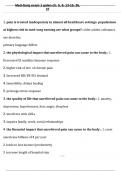Med-Surg exam 1 galen ch. 5, 9, 13-15, 36,
A
37
1.pain is treated inadequately in almost all healthcare settings. populations
at highest risk in med-surg nursing are what groups?: older adults, substance
use disorder,
primary language differs
2.the physiological impact that unrelieved pain can cause to the body.: 1.
Decreased GI motility/immune response
2.higher risk of dev. of chronic pain
3.Increased HR/BP/O2 demand
4.Immobility, delays healing
5.prolongs stress response
3.the quality of life that unrelieved pain can cause to the body.: 1. anxiety,
depression, hopelessness, fear, anger, sleepless
2.interferes with ADLs
3.impairs family, work, social relationships
4.the financial impact that unrelieved pain can cause to the body.: 1. costs
americans billions of $ per year
2. leads to lost income/productivity
3. increase length of hospital stay
, Med-Surg exam 1 galen ch. 5, 9, 13-15, 36,
37
5. Acute pain characteristics?: 1. short duration (<3mo.), well-defined cause
2.decrease w/ healing, usually reversible
3.initially serves biological purpose, when prolonged serves no purpose
4.may come with anxiety/restlessness
5.if unrelieved, can increase morbidity, mortality, & prolongs hospital stay
6.Persistent (Chronic) characteristics?: 1. lasts >3 mo, may or may not have
well-defined cause
2.begins gradually, persists & no useful purpose
3.can come with depression, fatigue, financial burden on fam, friends, healthcare
system, impact quality of life of family/friends
7.localized pain?: confined to one area, well defined
(ex: pain is in leg and that's the only spot I feel pain)
8.nociceptive (normal pain processing): results from skin, organ damage or
inflammation and can be somatic or visceral
(ex: skin, SQ, skeletal)
9.neuropathic (abnormal pain processing): nervous system with or without tis-
sue damage, often from nerve damage
(ex: phantom limb pain, postherpetic neuralgia pain)
10.Somatic pain physiological structure?: 1. cutaneous or superficial
, Med-Surg exam 1 galen ch. 5, 9, 13-15, 36,
37
2.originates in the skin, skeletal, SQ tissues
3.deep somatic: bone, muscle, blood vessels, connective tissues
, Med-Surg exam 1 galen ch. 5, 9, 13-15, 36,
37
11.somatic pain characteristics?: cutaneous/superficial: well localized, sharp,
throbbing
Deep: dull, aching, cramping
12.visceral pain physiological structure: organs & linings of body cavities
13.characteristics of visceral pain?: poorly localized
diffuse, deep cramping or pressure
sharp, stabbing sensation
14.neuropathic pain physiological structures?: 1. PNS or CNS
2. nerve fibers, spinal cord, & higher CNS
15.neuropathic pain characteristics?: poorly localized,
shooting, burning, fiery, shocklike,
tingling, painful, numbness
16.when pain receptors in tissues are activated this is known as what?: so-
matic pain
17.When pain is related to internal organs in the midline of the body.: visceral
pain
18.what is the best indicator of pt's true pain level?: self report (what pt says)
19.what pain scale would you use for a pt who is alert and oriented?: -




